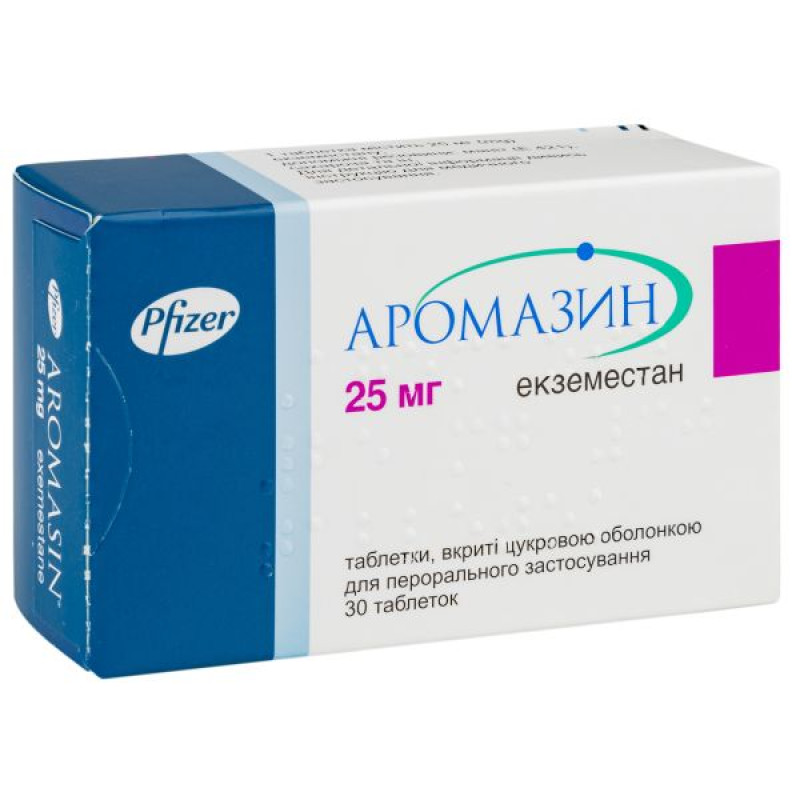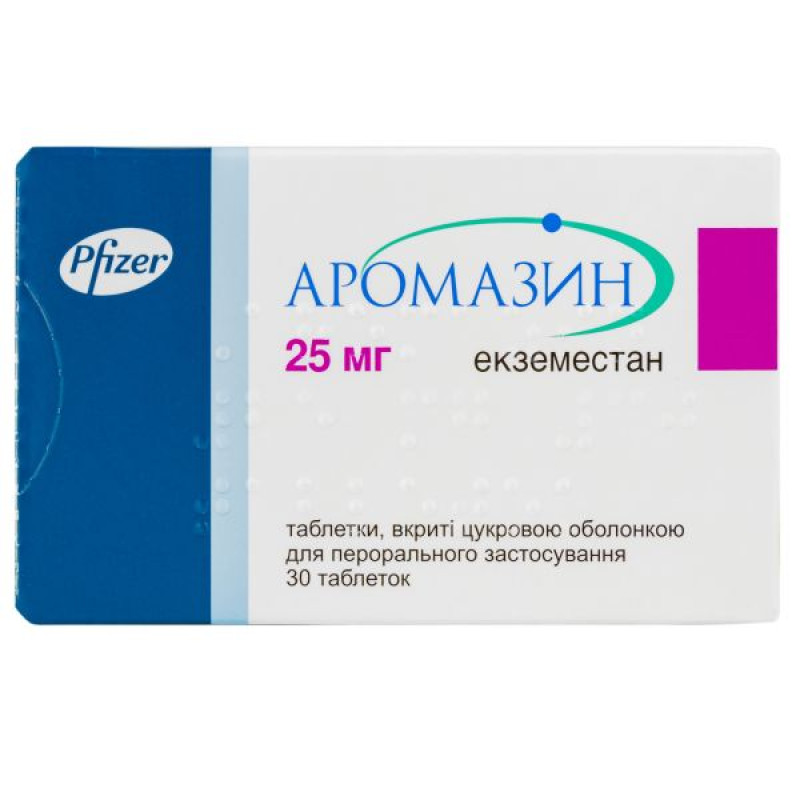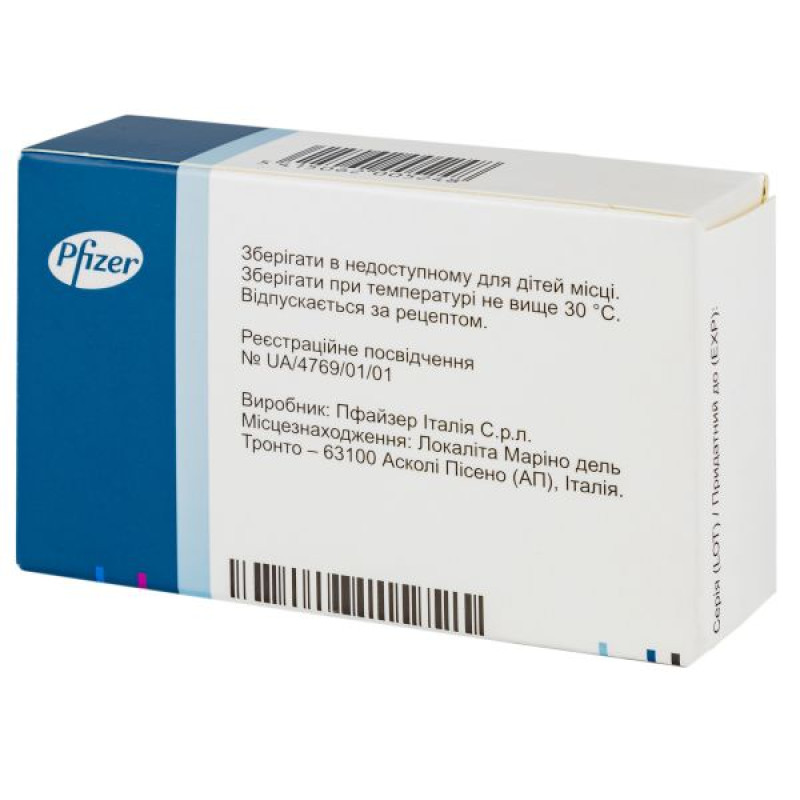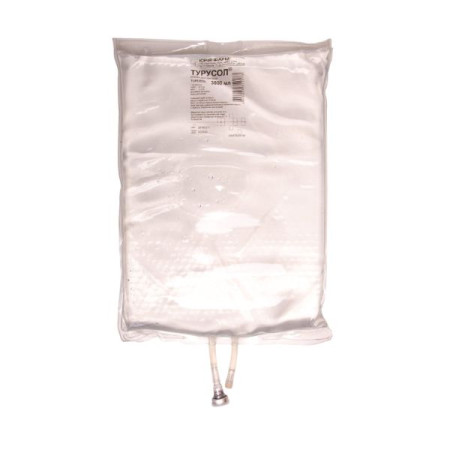Aromasin sugar-coated tablets 25 mg No. 30

Instructions for Aromasin sugar-coated tablets 25 mg No. 30
Composition
active ingredient: exemestane;
1 tablet contains exemestane 25 mg;
excipients: mannitol (E 421), hypromellose, polysorbate 80, crospovidone, colloidal silicon dioxide, microcrystalline cellulose, sodium starch glycolate (type A), magnesium stearate; sugar shell (hypromellose, simethicone emulsion, macrogol 6000, sucrose, light magnesium carbonate, titanium dioxide (E 171), methyl parahydroxybenzoate (E 218), polyvinyl alcohol, cetyl esters of wax, talc, carnauba wax); ink: shellac, iron oxide (E 172), titanium oxide (E 171), ethyl alcohol, isobutyl alcohol.
Dosage form
Sugar-coated tablets.
Main physicochemical properties: round, biconvex tablets, coated with a sugar shell, from almost white to slightly grayish in color, approximately 6 mm in diameter, with the numbers 7663 printed in black ink on one side.
Pharmacotherapeutic group
Hormone antagonists and similar agents. Aromatase inhibitors. ATX code L02B G06.
Pharmacological properties
Pharmacodynamics
Mechanism of action
Exemestane is an irreversible steroidal aromatase inhibitor, structurally similar to the natural substance androstenedione. In postmenopausal women, estrogens are produced primarily by the conversion of androgens to estrogens by the aromatase enzyme in peripheral tissues. Blocking estrogen production by inhibiting aromatase is an effective and selective treatment for hormone-dependent breast cancer in postmenopausal women. In postmenopausal women, exemestane significantly reduced serum estrogen concentrations starting at a dose of 5 mg; the maximum reduction (> 90%) was achieved at a dose of 10–25 mg. In postmenopausal patients with breast cancer who received 25 mg of the drug daily, total aromatase levels were reduced by 98%.
Exemestane has no progestogenic or estrogenic activity. A small androgenic activity, presumably related to the 17-hydroderivative, was observed mainly at high doses. In studies of long-term daily use, exemestane did not affect the biosynthesis of hormones such as cortisol or aldosterone in the adrenal glands, the levels of which were measured before or after the ACTH (adrenocorticotropic hormone) test; this demonstrated selectivity with respect to other enzymes involved in steroid metabolism.
In this regard, there is no need for replacement therapy with glucocorticoids and mineralocorticoids. A slight, dose-independent increase in serum levels of luteinizing and follicle-stimulating hormones is noted even at low doses; this effect, however, is expected for drugs of this pharmacological group; it probably develops by the principle of feedback, at the level of the pituitary gland, as a result of a decrease in estrogen concentration, which stimulates the secretion of gonadotropins by the pituitary gland (also in postmenopausal women).
Clinical efficacy and safety
Adjuvant therapy for early-stage breast cancer.
In a multicenter, randomized, double-blind study (IES – Intergroup Exemestane Study) conducted in 4724 postmenopausal women with estrogen receptor-positive primary breast cancer or estrogen receptor-undetermined primary breast cancer, patients who were free of recurrence after 2–3 years of adjuvant tamoxifen therapy were randomized to receive Aromasin (25 mg/day) or tamoxifen (20 or 30 mg/day) for 3–2 years to complete a 5-year course of hormonal therapy.
Follow-up with a median of 52 months in an intergroup study of exemestane.
Results from a study with a median treatment duration of approximately 30 months and a median follow-up of approximately 52 months demonstrated that continued treatment with Aromasin after 2–3 years of adjuvant tamoxifen therapy was associated with a clinically and statistically significant improvement in disease-free survival (DFS) compared with continued tamoxifen therapy. Results showed that during the observation period of the study, Aromasin reduced the risk of breast cancer recurrence by 24% compared with tamoxifen (hazard ratio 0.76; p = 0.00015). The greater benefit of exemestane compared with tamoxifen in terms of disease-free survival was evident regardless of lymph node status or prior chemotherapy.
The use of Aromasin also significantly reduced the risk of developing contralateral breast cancer (hazard ratio – 0.57; p = 0.04158).
0.85 (log rank test: p = 0.07362), representing a 15% reduction in the risk of death in favour of exemestane. A statistically significant 23% reduction in the risk of death (hazard ratio for overall survival 0.77; chi-square test (Wald test): p = 0.0069) was observed with exemestane compared with tamoxifen when adjusting for pre-specified prognostic factors (i.e. estrogen receptor status, lymph node status, prior chemotherapy, use of hormone replacement therapy and bisphosphonates).Key efficacy outcomes in all patients (patient population stratified by treatment assignment) and in patients with estrogen receptor-positive cancer at 52 months
Table 1.
End point Population | Exemestane Phenomena/N (%) | Tamoxifen Phenomena/N (%) | Risk ratio (95% CI) | p-value* |
| Disease-free survivala | ||||
| All patients | 354/2352 (15.1%) | 453/2372 (19.1%) | 0.76 (0.67–0.88) | 0.00015 |
| ER+ patients | 289/2023 (14.3%) | 370/2021 (18.3%) | 0.75 (0.65–0.88) | 0.00030 |
| Contralateral breast cancer | ||||
| All patients | 20/2352 (0.9%) | 35/2372 (1.5%) | 0.57 (0.33–0.99) | 0.04158 |
| ER+ patients | 18/2023 (0.9%) | 33/2021 (1.6%) | 0.54 (0.30–0.95) | 0.03048 |
| Breast cancer-free survivalb | ||||
| All patients | 289/2352 (12.3%) | 373/2372 (15.7%) | 0.76 (0.65–0.89) | 0.00041 |
| ER+ patients | 232/2023 (11.5%) | 305/2021 (15.1%) | 0.73 (0.62–0.87) | 0.00038 |
| Systemic recurrence-free survival | ||||
| All patients | 248/2352 (10.5%) | 297/2372 (12.5%) | 0.83 (0.70–0.98) | 0.02621 |
| ER+ patients | 194/2023 (9.6%) | 242/2021 (12.0%) | 0.78 (0.65–0.95) | 0.01123 |
| Overall survivalg | ||||
| All patients | 222/2352 (9.4%) | 262/2372 (11.0%) | 0.85 (0.71–1.02) | 0.07362 |
| ER+ patients | 178/2023 (8.8%) | 211/2021 (10.4%) | 0.84 (0.68–1.02) | 0.07569 |
* Log rank test; ER+ patients = patients with positive estrogen receptor test.
a Disease-free survival is defined as the first occurrence of local or systemic recurrence, contralateral breast cancer, or death from any cause.
b Breast cancer-free survival is defined as the first occurrence of local or systemic recurrence, contralateral breast cancer, or breast cancer death.
c Systemic recurrence-free survival is defined as the first occurrence of systemic recurrence or death from breast cancer.
d Overall survival is defined as the occurrence of death from any cause.
In an additional subgroup analysis of patients with positive or indeterminate estrogen receptor status, the unadjusted hazard ratio for overall survival was 0.83 (log rank test: p = 0.04250), representing a clinically and statistically significant 17% reduction in the risk of death.
Results from an additional bone assessment in the inter-group study of exemestane showed that women taking Aromasin after 2-3 years of tamoxifen treatment had a modest decrease in bone mineral density. In the overall study, the incidence of post-treatment fractures, assessed over a 30-month treatment period, was higher in patients taking Aromasin compared with those taking tamoxifen (4.5% vs. 3.3%, respectively, p=0.038).
Results from an endometrial follow-up study in the intergroup exemestane study showed that after 2 years of treatment, there was a median reduction in endometrial thickness of 33% in patients treated with Aromasin compared with no significant change in patients treated with tamoxifen. Endometrial thickening at baseline returned to normal (< 5 mm) in 54% of patients treated with Aromasin.
Median follow-up of 87 months in an intergroup study of exemestane.
Overall, a greater benefit of exemestane compared with tamoxifen in terms of disease-free survival was evident regardless of lymph node status or prior chemotherapy or hormonal therapy. Statistical significance was not found in several subgroups with small sample sizes. These showed a trend in favor of exemestane in patients with more than 9 positive nodes or prior chemotherapy with the CMF regimen (cyclophosphamide + methotrexate +
5-fluorouracil). In patients with unknown node status, other prior chemotherapy, and unknown/missing prior hormonal therapy status, there was a statistically insignificant trend in favor of tamoxifen.
In addition, exemestane also significantly prolonged breast cancer-free survival (hazard ratio 0.82; p = 0.00263) and systemic recurrence-free survival (hazard ratio 0.85; p = 0.02425).
Aromasin also reduced the risk of contralateral breast cancer, although the effect was no longer statistically significant during this follow-up period of the study (hazard ratio 0.74; p = 0.12983). In the overall study population, a trend towards improved overall survival was observed with exemestane (373 deaths) compared with tamoxifen (420 deaths), with a hazard ratio of 0.89 (log rank test: p = 0.08972), representing an 11% reduction in the risk of death in favor of exemestane. When adjusting for prespecified prognostic factors (i.e. estrogen receptor assay, lymph node status, prior chemotherapy, use of hormone replacement therapy, and bisphosphonates), a statistically significant 18% reduction in the risk of death (hazard ratio for overall survival 0.82; chi-square test (Wald test): p = 0.0082) was observed with exemestane compared with tamoxifen in the overall study population.
In an additional subgroup analysis of patients with positive or indeterminate estrogen receptor testing, the unadjusted hazard ratio for overall survival was 0.86 (log rank test: p = 0.04262), representing a clinically and statistically significant 14% reduction in the risk of death.
Results from an additional bone status study suggest that exemestane use for 2–3 years after tamoxifen use for 3–2 years resulted in increased bone loss during this treatment (mean % change from baseline in bone mineral density (BMD) at 36 months: -3.37 (spine), -2.96 (total hip) with exemestane and -1.29 (spine), -2.02 (total hip) with tamoxifen). However, at the end of the 24-month post-treatment period, the change in BMD from baseline in both treatment groups was minimal, with the final decrease in BMD in the tamoxifen group being slightly greater for all sites (mean % change in BMD from baseline at 24 months: -2.17 (spine), -3.06 (total hip) with exemestane and -3.44 (spine), -4.15 (total hip) with tamoxifen).
The number of all fractures reported during the treatment and follow-up periods was significantly higher in the exemestane group compared with the tamoxifen group (169 (7.3%) vs. 122 (5.2%); p = 0.004), but there was no difference in the number of fractures reported as a result of osteoporosis.
Treatment of advanced breast cancer.
In a randomized, comparative, controlled clinical trial, the use of Aromasin at a daily dose of 25 mg demonstrated a statistically significant increase in survival, time to disease progression, and time to failure compared with standard hormonal treatment with megestrol acetate in postmenopausal women with advanced breast cancer that progressed after or during tamoxifen treatment, used as adjuvant therapy or first-line therapy for advanced cancer.
Pharmacokinetics
Absorption
After oral administration of Aromasin tablets, exemestane is rapidly absorbed. The fraction of the dose absorbed from the gastrointestinal tract is high. Absolute bioavailability in humans has not been determined, although distribution is expected to be limited by the first-pass effect. A similar effect resulted in absolute bioavailability in rats and dogs of 5%. With a single dose of 25 mg, the mean plasma level reaches a maximum after 2 hours and is 18 ng/ml. Simultaneous administration of the drug with food increases its bioavailability by 40%.
Distribution
The volume of distribution of exemestane, uncorrected for oral bioavailability, is approximately 20,000 L. The pharmacokinetics of exemestane are linear and the terminal half-life of the drug is 24 hours. Plasma protein binding is 90% and is concentration-independent. Exemestane and its metabolites do not bind to erythrocytes. Exemestane does not accumulate in an unpredictable manner after repeated doses.
Exemestane is metabolized by oxidation of the methylene group (6) by CYP3A4 and/or by reduction of the 17-keto group by aldoketoreductase with subsequent conjugation. The clearance of exemestane is approximately 500 l/h without correction for oral bioavailability.
These metabolites are either inactive or less active than the parent compound in terms of aromatase inhibition. The amount of unchanged drug excreted in the urine is 1% of the dose. An equal amount (40%) of 14C-labeled exemestane was excreted in the urine and feces within a week.
Special groups
Age
No significant correlation was observed between systemic exposure to Aromasin and the age of the patients.
Patients with renal impairment
In patients with severe renal impairment (CLcr < 30 mL/min), systemic exposure to exemestane was twice as high as in healthy volunteers. Given the safety profile of exemestane, no dose adjustment is necessary.
Patients with hepatic impairment
In patients with moderate or severe hepatic impairment, exemestane exposure is 2-3 times higher than in healthy volunteers. Given the safety profile of exemestane, no dose adjustment is necessary.
Indication
Adjuvant therapy in postmenopausal women with estrogen receptor-positive early invasive breast cancer after 2–3 years of initial adjuvant tamoxifen therapy.
Treatment of advanced breast cancer in women with natural or induced postmenopausal status who have shown disease progression after antiestrogen therapy. Efficacy has not been demonstrated in estrogen receptor negative patients.
Contraindication
Aromasin is contraindicated in patients with known hypersensitivity to the active ingredient of the drug or to any other component of the drug listed in the "Composition" section. The drug is also contraindicated in premenopausal women, women during pregnancy or breastfeeding.
Interaction with other medicinal products and other types of interactions
In vitro studies have shown that this drug is metabolized by cytochrome P450 (CYP3A4) and aldoketoreductases (see section "Pharmacokinetics") and does not inhibit any of the major CYP isoenzymes. In a clinical pharmacokinetic study, it was found that specific inhibition of CYP3A4 by ketoconazole had no significant effect on the pharmacokinetics of exemestane.
In an interaction study with rifampicin, a potent CYP450 inducer, at a daily dose of 600 mg and a single dose of exemestane of 25 mg, the AUC of exemestane decreased by 54% and Cmax by 41%. Since the clinical significance of this interaction has not been studied, concomitant use of medicinal products such as rifampicin, anticonvulsants (e.g. phenytoin and carbamazepine) and herbal preparations containing St. John's wort, which are known to induce CYP3A4, may reduce the efficacy of Aromasin.
Aromasin should be used with caution with drugs that are metabolized by CYP3A4 and have a narrow therapeutic window. There is no clinical experience with the simultaneous use of Aromasin with other anticancer drugs.
Aromasin should not be used with estrogen-containing drugs, as their pharmacological effect is neutralized when used simultaneously.
Application features
Aromasin should not be prescribed to women with premenopausal endocrine status. Therefore, in appropriate clinical cases, postmenopausal status should be established by assessing LH, FSH, and estradiol levels.
Aromasin should be administered with caution to patients with impaired liver or kidney function.
Aromasin tablets contain sucrose and should not be administered to patients with rare hereditary forms of fructose intolerance, glucose-galactose malabsorption or sucrase-isomaltase insufficiency.
Aromasin tablets contain methyl parahydroxybenzoate, which may cause allergic reactions (possibly delayed).
Aromasin is a potent estrogen-lowering agent; decreased bone mineral density and increased fracture rates have been observed following use of the drug (see section 5.1). At the start of adjuvant therapy with Aromasin in women with or at risk of osteoporosis, baseline bone mineral density should be assessed based on current clinical guidelines and practices. Bone mineral density in patients with advanced disease should be assessed on an individual basis.
Although there is insufficient data on the effect of therapy in the treatment of bone mineral density loss caused by Aromasin, it is necessary to monitor the condition of patients using Aromasin and initiate treatment or prevention of osteoporosis in patients at risk.
Routine assessment of 25-hydroxyvitamin D levels should be performed before initiating aromatase inhibitor therapy, as severe vitamin D deficiency is common in women with early breast cancer. Women with vitamin D deficiency should receive supplemental vitamin D.
Ability to influence reaction speed when driving vehicles or other mechanisms
Drowsiness, somnolence, asthenia and dizziness have been reported during use of the drug. Patients should be informed that if these symptoms occur, their physical and/or mental reactions required for driving or operating machinery may be impaired.
Use during pregnancy or breastfeeding
Pregnancy. There are no clinical data on the use of Aromasin in pregnant women. Animal studies have shown reproductive toxicity, therefore Aromasin is contraindicated for use in pregnant women.
Breastfeeding. It is not known whether exemestane passes into breast milk. Aromasin should not be used by women who are breastfeeding.
Women in the perimenopausal period or women of reproductive age.
The physician should discuss the need for appropriate contraception with women of childbearing potential, as well as with women who are perimenopausal or recently postmenopausal, until their postmenopausal status is fully established (see sections “Contraindications” and “Special Precautions”).
Method of administration and doses
Adults and elderly patients.
Aromasin is recommended to be taken at a dose of 25 mg once daily, preferably after meals.
In patients with early breast cancer, treatment with Aromasin should be continued until the completion of five years of combined sequential adjuvant hormonal therapy (continuation of Aromasin therapy after tamoxifen) or until tumor recurrence occurs.
In patients with advanced breast cancer, treatment with Aromasin should be continued as long as tumor progression is evident.
No dose adjustment is required for patients with hepatic or renal impairment (see section 5.2).
Children
The drug is not recommended for use in children.
Overdose
Clinical studies have been conducted with Aromasin in a single dose of up to 800 mg in healthy female volunteers and in a dose of up to 600 mg per day in postmenopausal women with advanced breast cancer; these studies indicate that these doses are well tolerated. A single dose of Aromasin that can cause life-threatening symptoms has not been established. In animal studies, lethality was recorded after administration of a single oral dose equivalent to 2000 and 4000 times the recommended human dose on a mg/m2 basis, respectively. There is no specific antidote for overdose; symptomatic treatment should be provided. General supportive treatment is indicated, including frequent monitoring of vital signs and close observation of patients.
Adverse reactions
Aromasin was generally well tolerated in all clinical trials at the standard dose of 25 mg/day; adverse events were generally mild to moderate in severity. The rate of discontinuation due to adverse events was 7.4% in patients with early breast cancer who received adjuvant therapy with Aromasin after initial adjuvant therapy with tamoxifen. The most commonly reported adverse events were hot flashes (22%), arthralgia (18%), and fatigue (16%).
The incidence of discontinuation due to adverse events was 2.8% in the overall population of patients with advanced breast cancer. The most commonly reported adverse events were hot flashes (14%) and nausea (12%).
Most adverse events can be explained by the normal pharmacological effects of estrogen blockade (e.g. hot flashes).
Adverse reactions reported during clinical trials and post-marketing use of the drug are listed below by system organ class and frequency.
The frequency indicators are defined as follows: very common (≥ 1/10), common (≥ 1/100 to < 1/10), uncommon (≥ 1/1000 to < 1/100), rare (≥ 1/10,000 to < 1/1000), very rare (< 1/10,000), frequency unknown (cannot be estimated from the available data).
From the blood and lymphatic system: very often - leukopenia**; often - thrombocytopenia**; frequency unknown - decrease in the number of lymphocytes**.
Immune system disorders: uncommon – hypersensitivity.
Metabolic and nutritional disorders: often - anorexia.
On the part of the psyche: very often - depression, insomnia.
From the nervous system: very often - headache, dizziness; often - carpal tunnel syndrome, paresthesia; rarely - somnolence.
Vascular: very often - hot flashes.
From the gastrointestinal tract: very often - abdominal pain, nausea; often - vomiting, diarrhea, constipation, dyspepsia.
Hepatobiliary system: very common - increased levels of liver enzymes, increased levels of bilirubin in the blood, increased levels of alkaline phosphatase in the blood; rare - hepatitis†, cholestatic hepatitis†.
Skin and subcutaneous tissue disorders: very common: increased sweating; common: alopecia, rash, urticaria, pruritus; rare: acute generalized exanthematous pustulosis†.
General disorders and administration site conditions: very common - pain, fatigue; common - peripheral edema, asthenia.
* Includes arthralgia and less commonly pain in extremity, osteoarthritis, back pain, arthritis, myalgia and joint stiffness.
** In patients with advanced breast cancer, thrombocytopenia and leukopenia have been reported rarely. Intermittent decreases in lymphocyte counts have been observed in approximately 20% of patients treated with Aromasin, particularly in patients with pre-existing lymphopenia. However, mean lymphocyte counts in these patients did not change significantly over time and there was no corresponding increase in the incidence of viral infections. These effects were not observed in patients treated in early breast cancer studies.
† Frequency calculated using the 3/X rule.
Table 2 shows the incidence rates of pre-specified adverse reactions and diseases in an inter-group study of exemestane in patients with early breast cancer, regardless of causality, reported in patients receiving study drug therapy and up to 30 days after its completion.
Table 2.
| Adverse reactions and diseases | Exemestane (N = 2249) | Tamoxifen (N = 2279) |
| Tides | 491 (21.8%) | 457 (20.1%) |
| Increased fatigue | 367 (16.3%) | 344 (15.1%) |
| Headache | 305 (13.6%) | 255 (11.2%) |
| Insomnia | 290 (12.9%) | 204 (9.0%) |
| Increased sweating | 270 (12.0%) | 242 (10.6%) |
| Gynecological diseases | 235 (10.5%) | 340 (14.9%) |
| Dizziness | 224 (10.0%) | 200 (8.8%) |
| Nausea | 200 (8.9%) | 208 (9.1%) |
| Osteoporosis | 116 (5.2%) | 66 (2.9%) |
| Vaginal bleeding | 90 (4.0%) | 121 (5.3%) |
| Other primary cancer | 84 (3.6%) | 125 (5.3%) |
| Vomiting | 50 (2.2%) | 54 (2.4%) |
| Vision impairment | 45 (2.0%) | 53 (2.3%) |
| Thromboembolism | 16 (0.7%) | 42 (1.8%) |
| Osteoporotic fracture | 14 (0.6%) | 12 (0.5%) |
| Myocardial infarction | 13 (0.6%) | 4 (0.2%) |
In the intergroup study of exemestane, the incidence of myocardial ischemia events in the exemestane and tamoxifen treatment groups was 4.5% and 4.2%, respectively. No significant differences were observed for any individual cardiovascular events, including hypertension (9.9% vs. 8.4%), myocardial infarction (0.6% vs. 0.2%), and heart failure (1.1% vs. 0.7%).
In an intergroup study of exemestane, exemestane was associated with a higher incidence of hypercholesterolemia compared with tamoxifen (3.7% vs. 2.1%).
In a separate double-blind, randomized trial of postmenopausal women with low-risk early breast cancer treated with exemestane (N = 73) or placebo (N = 73) for 24 months, exemestane was associated with a mean decrease in plasma HDL-cholesterol of 7–9% compared with a 1% increase in the placebo group. There was also a 5–6% decrease in apolipoprotein A1 in the exemestane group compared with a 0–2% decrease in the placebo group. The effects on all other lipid parameters analyzed (total cholesterol, LDL-cholesterol, triglycerides, apolipoprotein-B, and lipoprotein-a levels) were similar in the two treatment groups. The clinical significance of these findings is unknown.
In an inter-group study of exemestane, gastric ulcers were observed more frequently in the exemestane group compared with the tamoxifen group (0.7% versus <0.1%). Most patients who used exemestane and developed gastric ulcers were also taking concomitant and/or previously taking NSAIDs.
Reporting of suspected adverse reactions.
Reporting suspected adverse reactions after the registration of a medicinal product is an important measure. This allows for continuous monitoring of the benefit/risk balance of the medicinal product. Physicians are asked to report any suspected adverse reactions.
Expiration date
3 years.
Storage conditions
Store at a temperature not exceeding 30 °C.
Keep out of reach of children.
Packaging
15 tablets in a blister, 2 blisters in a cardboard box.
Vacation category
According to the recipe.
Producer
Pfizer Italy S.r.l.
Location of the manufacturer and its business address
The location of Marino del Tronto is 63100 Ascoli Piceno (AP), Italy.
There are no reviews for this product.
There are no reviews for this product, be the first to leave your review.
No questions about this product, be the first and ask your question.









